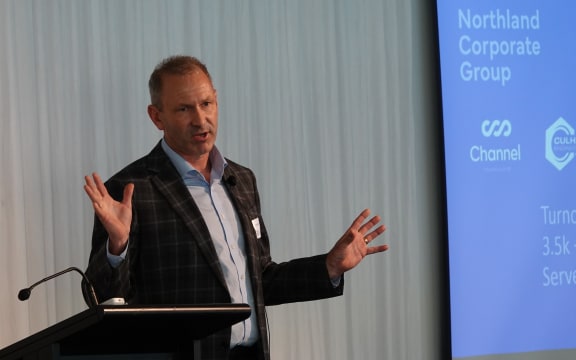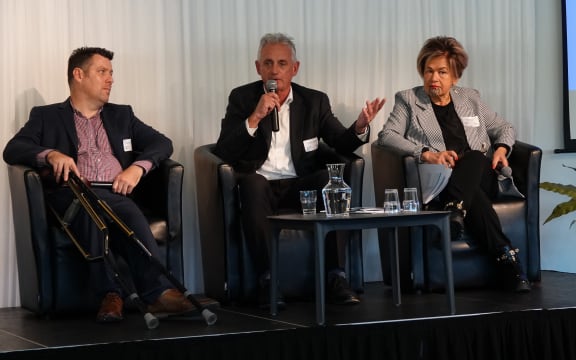
State Highway 1 through Whangārei, one of the sections which has been four-laned in recent years.
Photo: RNZ
Building a four-lane expressway from Auckland to Kaikohe could benefit the region by more than $500m a year and the government should start work now, a report has found.
Those are among the findings of a report commissioned by the Northland Corporate Group (NCG), representing five of the region’s biggest companies, and written by thinktank New Zealand Institute of Economic Research (NZIER) .
The report’s authors said “robust and resilient” road connections were needed to unlock Northland’s potential, and urged the government to upgrade the “dilapidated” State Highway 1 between Auckland and Whangārei as soon as possible.
That could be followed by making the road between Whangārei and Kaikohe four lanes.
The report was launched at Whangarei’s Semenoff Stadium on Tuesday afternoon.
NCG co-chair and Northpower chief executive Andrew McLeod said Northland’s resources and proximity to Auckland meant the region was well positioned to contribute to the national economy.
However, decades of chronic underinvestment and patchwork upgrades to SH1 had isolated Northland and tarnished the region’s business reputation, he said.

Northland Corporate Group co-chair Andrew McLeod speaks at the launch of the Northland Expressway report.
Photo: RNZ
McLeod applauded the government’s commitment to a new four-lane route around the Brynderwyn Hills, and to four-laning the highway from Whangarei to Port Marsden, and Warkworth to Wellsford.
“But greater ambition is needed,” he said.
The NCG was calling for a wholesale upgrade of SH1 from Auckland to Whangārei and beyond to Kaikohe.
“Without that, we’re stuck in a loop of piecemeal upgrades creating bottlenecks and backlogs that will continue to be the chokehold on our economic potential,” McLeod said.
He also called on the Government to use its new fast-track consenting to accelerate construction of the Northland Expressway, given the fragile nature of the current highway and the likelihood of increasingly frequent extreme weather.
McLeod said building “critical road linkages” between Auckland, Waikato and the Bay of Plenty had led to economic growth, improved social outcomes and more residential development in those regions.
The same could happen in the North, he said.
‘We can’t wait any longer’
Rob Kirwan, managing director of Culham Engineering, said his company moved 25,000 tonnes of steel up and down SH1 each year.
The Brynderwyns closure meant trucks had to travel via Dargaville, adding an extra day, and costs that couldn’t be recovered, to the journey.
Kirwan said he’d seen many reports calling for a better roads over the years, but this one was different.
That was in part because most political parties agreed the highway needed to be fixed.
“We can’t wait any longer. We just need to get around the table to central government and get them to help us get this going.”
Kirwan said the next step was for Northlanders to make their voices heard by converging on social media, their MPs and government.
Murray Jagger, chairman of Northport and Marsden Maritime Holdings, said given the chance Northland could solve many of Auckland’s growing pains.
Whangārei had the only deepwater port in New Zealand with room for expansion – but shipping lines had backed away from using it after the highway’s repeated closures.
Jagger said he had watched the transformation of Hamilton, from provincial centre to thriving city, as the Waikato Expressway was built.
“The vitality it’s brought to the region is huge, and Northland will be exactly the same. As soon as you bring connectivity, all of a sudden you’ve got vitality and people will want to move here.”
Transport Minister Simeon Brown has been approached for comment.
Addressing Tuesday’s launch, Northland MP Grant McCallum said the current government was focussed on infrastructure and getting things done.
It had brought back Roads of National Significance and introduced fast-track consenting to speed up major projects, he said.
Report findings
The authors of the Te Tai Tokerau Northland Expressway report found building a four-lane road all the way to Kaikohe would bring “quantified monetary benefits” of $299m to $562m a year by 2050.
Those benefits arose from reduced travel times for people and freight, fewer weather-related closures, and fewer serious crashes.

Panel speakers, from left, the report’s lead author Michael Bealing, McKay Ltd managing director Lindsay Faithfull, and Tupu Tono Ngāpuhi Investment Fund director Ripeka Evans.
Photo: RNZ
Average travel speeds would increase from the current 67km/h to 80-90km/h, the duration of road closures would drop by 50-100 percent, and deaths and serious injuries would fall by 33-67 percent, the report predicted.
It noted however, that the expressway could increase carbon emissions due to increased road travel.
The report took into account the findings of a major survey of 800 Northland businesses carried out in 2023.
More than half said a four-lane highway would increase their revenue and reduce costs by at least 5 percent, half said they would hire more staff, and a third would bring forward more than $100,000 of investment.
Based on those survey results, the report’s authors estimated Northland businesses would lift their productivity by 2.5 percent, and Northland’s GDP would increase by $2.1 billion per year by 2048.
The expressway would also boost GDP in the rest of the country by an estimated $1.2 billion.
While no costings have been done for a four-lane Northland Expressway, the authors noted similar projects had cost between $30m and $60m per kilometre.
That would make a total cost of $5.5 billion to $11.1 billion, with the 98km Warkworth-Whangārei section costing an estimated $3.0-$5.9b and the 86km from Whangārei-Kaikohe about $2.6-$5.1b.
By comparison, the famously expensive, 56km-long Transmission Gully project near Wellington cost $1.5 billion, while the 128km Waikato Expressway came with a price tag of just over $1.6 billion.
The report writers said the government should start work immediately on a detailed options appraisal, design, and full cost-benefit analysis.
The government should also investigate the use of private financing to accelerate the project, they added.



